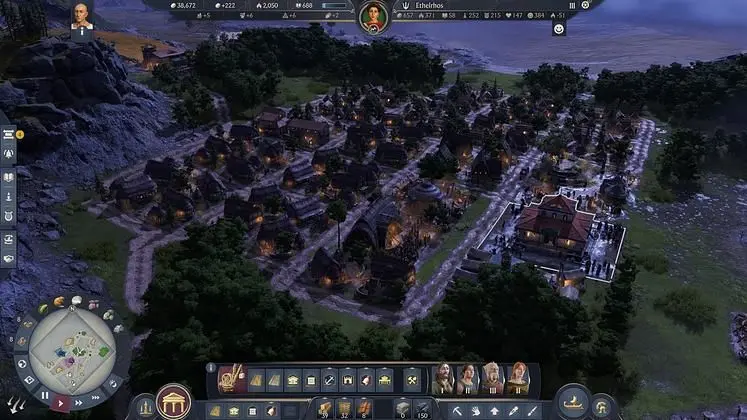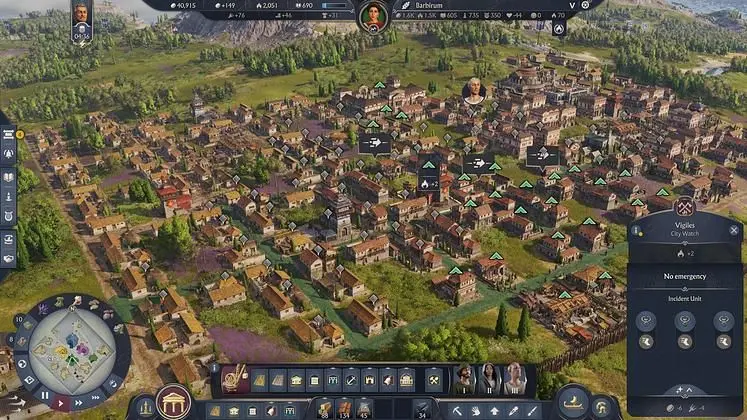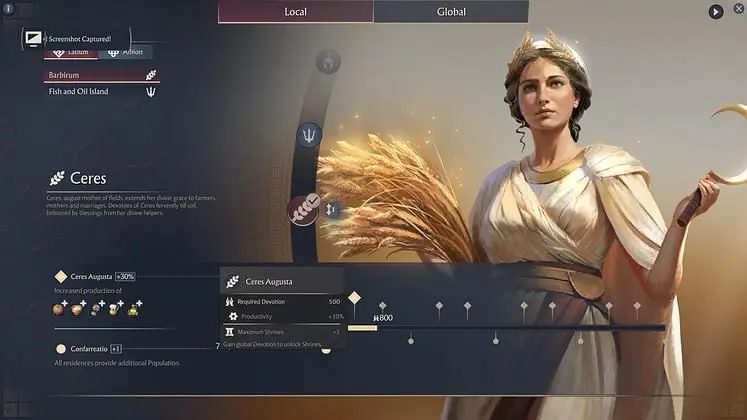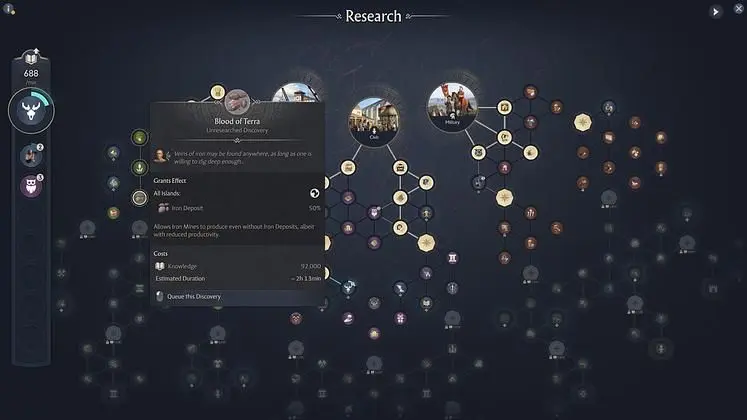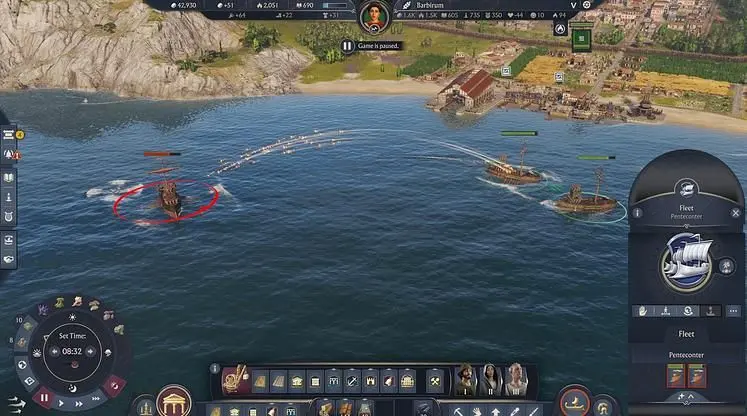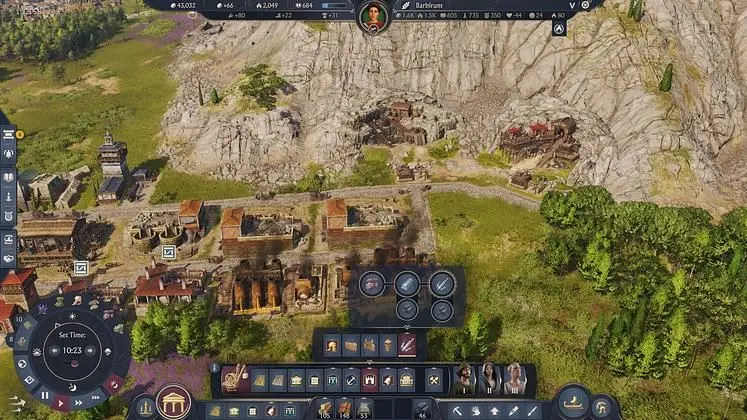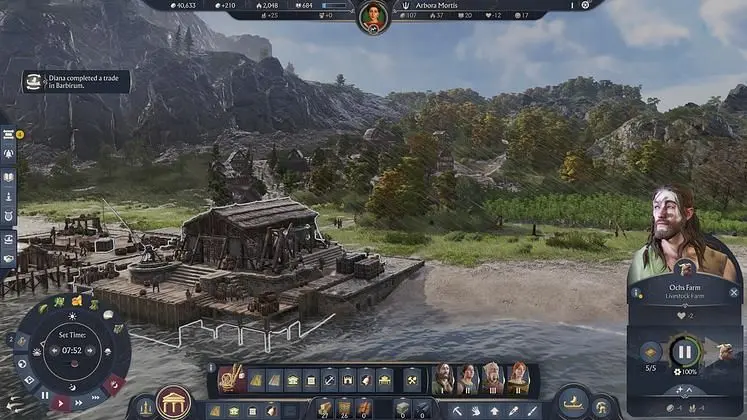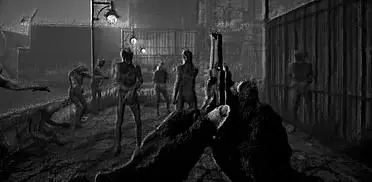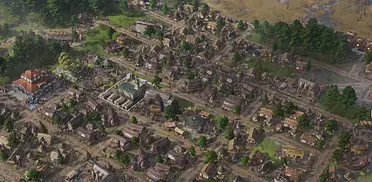Throughout its lengthy history, Ubisoft’s Anno series has never peered as far into the past as Anno 117: Pax Romana does. Yet, for all the ancient architecture gradually taking over lush, green islands and the promise of aqueducts hiding behind one of the many building buttons on its slick UI, a strong sense of familiarity pervades my effort of setting roots in the province of Latium.
Being given a trading post and some starting resources, I secure a steady supply of vital wood before building my first few homes. These humble abodes house Liberti, the first tier of population in Anno 117’s Italy-inspired region. I can satisfy their needs through simple two-building production chains, but as Plebeians and Equites join my city, things ramp up.
The complexity of producing goods increases, involving several building types that process resources at varying rates, and – depending on how unlucky you are – they may require discovering and settling other islands that have the resource fertilities your starting chunk of land might lack.
Although you don’t have to fulfill every need in each category to upgrade your population, lacking the ability to harvest Lavender or Dye Plants on your starter island can make you miss out on certain bonuses which, this time around, provide more than just boosts to the number of inhabitants and income.
While satisfied citizens remain the primary way of bringing more denarii into your coffers, production buildings can now boost income in a radius around them. The city building puzzle has even more pieces, as some of these structures also come with negative effects like reducing fire safety, in the case of charcoal huts and wire-twisters, or disease, in the case of pig farms. Then, they can also improve the generation of Belief, which sustains religion, or Knowledge, used to research new technologies.
Through religion, you can assign a god from either the Roman or Celtic pantheons to each island you control. Islands gather Devotion based on their generated Belief, reaping various benefits as they progress through a linear track in what’s a rather hands-off system. My main island in Latium followed Ceres, gaining additional population from residences when hitting specific Devotion thresholds alongside productivity bonuses to several production chains like bread or porridge.
Over in Albion, my people prayed to Neptune, which made sure I gathered cockles quicker and decreased upkeep for ships. You can switch between deities at any time at the cost of resetting your Devotion and losing earned bonuses. Since you don’t start with all gods unlocked, you also need to research them through the tech tree.
Another new addition in Anno 117: Pax Romana, the tech tree’s branches stretch decently far without overwhelming, being split into three categories – economic, civic, and military. The research options within unlock more than just the aforementioned gods, granting access to new buildings, upgrades for your trading posts and warehouses, new combat units, and improved area bonuses from structures.
You can freely choose what to prioritize, although some technologies are gated behind specific requirements. You can’t build Scorpiones before having a siege workshop, just like you can’t drain marshland before choosing to romanize the population of Albion.
The second playable region in Anno 117: Pax Romana, Albion is the somewhat darker and considerably wetter home of the Celts. Building up your settlements and satisfying your population follows similar rules to Latium, but this land does come with a few particularities that set it apart. Different types of population with mostly new demands are, perhaps, expected, but marshlands represent one of the more notable obstacles you’ll encounter.
Required by certain Celtic production buildings, they occupy a significant portion of islands, challenging you to be more mindful of how you utilize space. Your people live in tightly knit villages rather than sprawling cities, at least initially.
Placing production buildings inside marshlands has its own challenges as – without meticulous planning – I either had to sacrifice productivity and wood to set up an efficient footbridge network or risk having my ochs farms regularly succumb to disease, as they were out of reach of my Medici buildings.
When upgrading to the second tier, Albion’s population can choose one of two paths – Celtic, which embraces traditions, or Romano-Celtic, which adopts elements of their conquerors’ culture. Opting for the latter allows you to drain the marshlands, reclaiming those parts of your islands and introducing a gameplay dynamic I’m keen on exploring more in the full game.
Upon reaching the third tier – Alders – you can opt to upgrade your remaining tier 1 pops into either of the two paths, so you’re only temporarily locked out of the other choice, although I can’t say if mixing the two on the same island is efficient.
This is also the point at which Albion gets unlocked when starting in Latium – you can choose your starting province in the Sandbox mode – and when citizens begin requesting goods produced in the other region, more or less forcing you to set up trade if you somehow haven’t already.
As you roam between islands, you will sooner or later have to resort to violence as raiders and competing AI players endanger your assets. As someone who plays Anno games for the bits that don’t involve combat, – at best I find it to be a tolerable distraction, at worst a nuisance –, what I saw of Pax Romana’s naval engagements failed to win me over, while its returning land combat largely remains a mystery beyond knowing that the Roman barracks has six available unit types.
The six types of ships available in the Latium shipyard – three civilian, three military – are customizable to an extent, trading cargo slots for upgrades that provide speed or offensive power. But my battles with the local raiders largely came down to right-clicking on the closest target and watching volleys of fire arrows fly through the air before the weaker ship sank. Certainly far less engaging than figuring out how many buildings of each type I need to run an efficient mid-game production chain.
Interacting with AI players feels a bit smoother this time around. Diplomacy treads similar lines to Anno 1800’s, but its barrage of quests has been replaced with contracts that you accept at your own pace. Your relationship with the Emperor, however, is one you’ll want to keep a closer eye on.
Depending on the choices made during events and quests, you can either see it rise or drop. A higher reputation grants bonuses like the ability to re-roll items at traders and lower island settlement costs – which, in my experience, were a bit high in the preview build. Should reputation drop too low, he will consider you a rebel and attack.
As far as Anno 117: Pax Romana’s campaign goes, its first act sees you taking on the role of a fledgling governor – male or female – tasked with rebuilding a city devastated by a volcanic eruption. In true series tradition, it proves an effective way of introducing you to key concepts and production chains at a relaxed pace.
There’s a slightly bigger focus on the narrative this time around, which, without spoiling anything, I found largely inoffensive. However, I didn’t particularly enjoy its tendency to pull me away from my city so I could watch – admittedly detailed – 3D models of characters converse.
Some of the dialog choices provide context and additional information, others allow you to handle situations differently, yielding various rewards; but every time one would pop up, I simply wished I could get back to building.
A much bigger nuisance stems from the UI’s reliance on grouped buttons, which involves clicking one too many times to reach production chains when playing using mouse and keyboard. This does remove some of the initial information overload its predecessor was guilty of, but I still feel that seeing a long line of icons was preferable to scrolling horizontally and clicking through several buttons whenever I wanted to plop down a building.
Anno 117: Pax Romana’s opening hours reveal a fairly safe sequel that, so far, seems to understand quite well why its predecessor’s blueprint was beloved enough to spawn four seasons of post-launch support, determinedly using it as its foundation. The addition of research and religion trees provides a welcome bit of extra choice and flavor, while the bonuses production buildings offer in a radius around them could encourage unlearning old habits and thinking about city layouts differently.
If you were hoping for something vastly different from Anno 1800, Pax Romana’s opening hours may struggle to convince you to stick around. Yet, as someone who enjoyed the series’ historical entries and finds plenty of comfort in its approach to city building, I found myself easily losing track of time watching my cities grow, even if I couldn’t fully shake off the urge to check for layout-ruining trains in the forest.
Anno 117: Pax Romana is slated to launch on November 13, 2025, on PC, PS5, and Xbox Series X/S.
For the latest gaming news, follow GameWatcher on BlueSky, check out our videos on YouTube, or give us a like on Facebook. We sometimes include affiliate links in our posts, which grants us a small commission, thank you. Please support independent Games Media. ❤️
